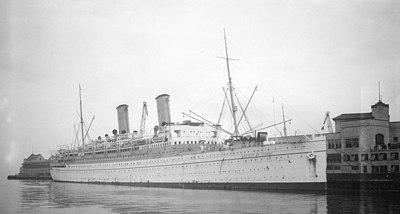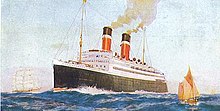 Empress of France at Pier B, Vancouver
| |
| History | |
|---|---|
| Name | Alsatian |
| Owner | Allan Line, Liverpool |
| Port of registry | United Kingdom |
| Launched | 22 March 1913 |
| Maiden voyage | 17 January 1914 |
| Fate | Sold to Canadian Pacific Ocean Service in 1919 |
| Name | Empress of France |
| Owner | |
| Port of registry | Canada |
| Fate | Scrapped 1934 |
| General characteristics | |
| Type | Ocean liner |
| Tonnage | 18,481 GRT |
| Length | 571.4 ft (174.2 m) |
| Beam | 72.4 ft (22.1 m), |
| Propulsion | turbines driving 4 shafts |
| Speed | 18 knots |
RMS Empress of France, formerly SS Alsatian was an ocean liner built in 1913-1914 by William Beardmore and Company at Glasgow in Scotland for Allan Line.[1] In total, the ship's service history encompasses 99 trans-Atlantic voyages, 5 trans-Pacific voyages, and 8 other cruises in addition to her war service.[1]
Service
[edit]This ship was the first North Atlantic liner with a cruiser stern. The vessel was built by William Beardmore & Co Ltd. at Glasgow. She was an 18,481 gross register tonnage ship, length 571.4 ft x beam 72.4 ft (22.1 m), two funnels, two masts, four propellers and a speed of 18 knots. Her initial configuration provided accommodation for 287 1st class, 504 2nd class and 848 3rd class passengers.[1]
The ocean liner was initially launched as SS Alsatian on 22 March 1912. She sailed from Liverpool on her maiden voyage to Saint John, New Brunswick for the Allan Line on 17 January 1914. On 22 May 1914, set out on her first trans-Atlantic crossing from Liverpool to Quebec.

Her last voyage that summer began on 17 July 1914; and when she returned to Europe, the nascent war in Europe brought a close to this truncated peacetime period of the ship's history.[1]
World War I
[edit]During the First World War, Alsatian was converted into an Armed Merchant Cruiser, with an initial armament of eight 4.7-inch (120-mm) guns, although she was later re-armed with eight 6-inch (152-mm) guns and two 6-pounder (57-mm) anti-aircraft guns.[2] Following conversion, she joined the 10th Cruiser Squadron patrolling off the Shetland Islands as part of the Northern Patrol maintaining the blockade of Germany. HMS Alsatian became flagship for Rear-Admiral Sir Dudley de Chair.[3] Later, Alsatian served as flagship for Vice-Admiral Sir Reginald Tupper. During the war years, she became one of the first ships to be fitted with the new wireless direction-finding apparatus. After the squadron was retired in 1917, she was re-fitted for peacetime service.[1]
Between the wars
[edit]
At war's end, the ship was added to the fleet of Canadian Pacific Ocean Services Ltd. (CP), which absorbed the entire Allan Line fleet. On 28 September 1918, Alsatian began her first voyage from Liverpool to Canada as a newly flagged ship of the Canadian Pacific fleet. After a second, trans-Atlantic voyage, Alsatian was taken out of service for refitting at Glasgow.[1]
The ship was renamed Empress of France on 4 April 1919.
The first voyage as Empress of France began on 26 September 1919. She sailed from Liverpool to Quebec. On 3 May 1922, her regular route was changed; and she sailed between Southampton, Cherbourg and Quebec. On 31 May 1922, the route was modified yet again; and she sailed between Hamburg, Southampton, Cherbourg and Quebec.[1]
Empress of France was one of four ocean liners to circumnavigate the world in 1923.[4]
In 1924, the ship was converted from coal to oil fuel.[1] In July 1926, her interiors were re-configured as 1st-class, 2nd-class, tourist-class and 3rd-class accommodations. In January 1927, the interior was again re-configured as 1st-class, tourist-class and 3rd-class.[1]
Voyages
[edit]| Departure | From | Arrival | To | Notes and notable passengers | Source |
|---|---|---|---|---|---|
| 26 September 1919 | Liverpool, United Kingdom | 5 October 1919 | Montreal, Quebec, Canada | ||
| October 1919 | Quebec, Canada | 16 October 1919 | Liverpool, United Kingdom | ||
| 21 October 1919 | Liverpool, United Kingdom | 28 October 1919 | Quebec, Canada | ||
| November 1919 | Quebec, Canada | 8 November 1919 | Liverpool, United Kingdom | Marquess of Anglesey | |
| 14 November 1919 | Liverpool, United Kingdom | 21 November 1919 | Montreal, Quebec, Canada | [5] | |
| November 1919 | Quebec, Canada | 3 December 1919 | Liverpool, United Kingdom | Harrison Watson, Canadian Government's Chief Trade Commissioner in the United Kingdom | [6] |
| 7 January 1920 | Liverpool, United Kingdom | 16 January 1920 | Saint John, New Brunswick, Canada | ||
| 21 January 1920 | Saint John, New Brunswick, Canada | 29 January 1920 | Liverpool, United Kingdom | Lady Dorothy Cavendish, daughter of the Duke of Devonshire (Governor General of Canada)
Captain Harold Macmillan, Aide-de-Camp to the Duke |
|
| February 1920 | Liverpool, United Kingdom | 28 February 1920 | Saint John, New Brunswick, Canada | ||
| 12 March 1920 | Saint John, New Brunswick, Canada | 22 March 1920 | Liverpool, United Kingdom | Duke of Devonshire | [7] |
| April 1920 | Saint John, New Brunswick, Canada | 19 April 1920 | Liverpool, United Kingdom | ||
| 1 May 1920 | England | May 1920 | Quebec, Canada | Duke of Devonshire
Sir James McKechnie, Head of Vickers |
[8] |
| May 1920 | Quebec, Canada | 22 May 1920 | Liverpool, United Kingdom | ||
| June 1920 | Quebec, Canada | 24 June 1920 | Liverpool, United Kingdom | ||
| 30 June 1920 | Liverpool, United Kingdom | 8 July 1920 | Quebec, Canada | [9] | |
| July 1920 | Quebec, Canada | 22 July 1920 | Liverpool, United Kingdom | ||
| August 1920 | Quebec, Canada | 18 August 1920 | Liverpool, United Kingdom | ||
| September 1920 | Quebec, Canada | 15 September 1920 | Liverpool, United Kingdom | ||
| October 1920 | Quebec, Canada | 13 October 1920 | Liverpool, United Kingdom | ||
| November 1920 | Quebec, Canada | 10 November 1920 | Liverpool, United Kingdom | ||
| 15 December 1920 | Liverpool, United Kingdom | 23 December 1920 | Saint John, NB, Canada | ||
| 27 July 1922 | Southampton, United Kingdom | Quebec and Montreal, Canada | [10] | ||
| September 1922 | Southampton, United Kingdom | Quebec and Montreal, Canada | [11] | ||
| 8 August 1923 | Southampton, United Kingdom | 14 August 1923 | Quebec, Canada | Sir Herbert Samuel Holt, president of the Royal Bank of Canada[12] | [12] |
| 5 September 1923 | Southampton, United Kingdom | September 1923 | Quebec, Canada | [13] | |
| 4 October 1923 | October 1923 | Canada | [14] | ||
| 9 February 1926 | New York, NY | 5 June 1926 | Quebec, Canada | via Mediterranean and Southampton, UK | |
| 26 June 1926 | Southampton, United Kingdom | 3 July 1926 | Quebec, Canada | ||
| 30 April 1927 | Southampton, United Kingdom | May 1927 | Quebec, Canada | via Cherbourg, France | [15] |
| 7 January 1928 | Southampton, United Kingdom | West Indies, South America, South Africa, East Africa, Egypt, Mediterranean | [16] | ||
| July 1928 | Quebec, Canada | 18 July 1928 | Southampton, United Kingdom | ||
| 6 September 1930 | Southampton, United Kingdom | September 1930 | Quebec, Canada | via Cherbourg, France | [17] |
| 18 April 1931 | Southampton, United Kingdom | April 1931 | Montreal, Canada | via Cherbourg, France | [18] |
| 5 August 1931 | Southampton, United Kingdom | August 1931 | Quebec, Canada | Lord Shaughnessy, Lieutenant Colonel Sir Martin Archer-Shee | [19] |
On 9 September 1927, Empress of France set out on what was to be her final Hamburg - Southampton - Cherbourg - Quebec voyage. On 8 September 1928, she sailed on final Southampton - Cherbourg - Quebec voyage before being transferred to the Pacific.[1]
On 31 October 1928, she sailed from Southampton for Suez, Hong Kong and Vancouver. Subsequently sailed on the Pacific until 17 October 1929 when she left Hong Kong en route to Liverpool.[1]
On 2 September 1931, Empress of France set out for what was to be her final voyage from Southampton to Cherbourg and Quebec; and in then she was laid up in the Clyde.[1] Empress of France was scrapped at Dalmuir on 20 October 1934.[1] Some of its interior timber panelling was used in the extension (completed in 1937) of St John the Baptist's Catholic Church in Padiham, Lancashire.[20]

Notable passengers
[edit]- 1923
- Prince of Wales[13]
- Sir Harold and Lady Boulton[14]
See also
[edit]- CP Ships
- List of ocean liners
- List of ships in British Columbia
- Ronald Niel Stuart VC, DSO, Staff Captain (1924–1926)
- HMS Calgarian - Alsatian's sister ship
References
[edit]- ^ a b c d e f g h i j k l m Ship List: Description of Empress of France Archived 4 February 2012 at the Wayback Machine
- ^ Dittmar and Colledge 1972, p. 119.
- ^ Suydam, Henry. "How the British Blockade Works: An Interview with Rear-Admiral Sir. Dudley de Chair, KCB, MVO," Brooklyn Eagle (New York). 1916.
- ^ Maxtone-Graham, John. (2000). Liners to the Sun, p. 124.
- ^ The Times, Thursday, 23 Oct 1919; pg. 2; Issue 42238; col A
- ^ The Times, Saturday, 6 Dec 1919; pg. 11; Issue 42276; col B
- ^ The Times, Saturday, 28 Feb 1920; pg. 19; Issue 42346; col A
- ^ The Times, Monday, 26 Apr 1920; pg. 17; Issue 42394; col B
- ^ "Ancestry.com - Canadian Passenger Lists, 1865-1935 - Quebec, Quebec; 1920; July; Microfilm page 200 to 262 of 838"
- ^ The Times, Wednesday, 26 Jul 1922; pg. 2; Issue 43093; col A
- ^ The Times, Tuesday, 19 Sep 1922; pg. 2; Issue 43140; col A
- ^ a b The Times, Thursday, 9 Aug 1923; pg. 11; Issue 43415; col A
- ^ a b The Times, Tuesday, 21 Aug 1923; pg. 8; Issue 43425; col D
- ^ a b The Times, Friday, 5 Oct 1923; pg. 13; Issue 43464; col B
- ^ The Times, Friday, 22 Apr 1927; pg. 2; Issue 44562; col A
- ^ The Times, Friday, 22 Jul 1927; pg. 2; Issue 44640; col A
- ^ The Times, Saturday, 6 Sep 1930; pg. 2; Issue 45611; col A
- ^ The Times, Saturday, 18 Apr 1931; pg. 13; Issue 45800; col B
- ^ The Times, Thursday, 6 Aug 1931; pg. 13; Issue 45894; col B
- ^ "Padiham – St John the Baptist". Catholic Trust for England and Wales and English Heritage. 2011. Retrieved 19 August 2019.
Bibliography
[edit]- Dittmar, F. J.; Colledge, J. J. (1972). British Warships 1914–1919. Shepperton, UK: Ian Allan. ISBN 0-7110-0380-7.
- Jellicoe, John (1919). The Grand Fleet 1914–16: Its Creation, Development and Work. London: Cassell and Company. OCLC 859842281.
- Osborne, Richard; Spong, Harry; Grover, Tom (2007). Armed Merchant Cruisers 1878–1945. Windsor, UK: World Warship Society. ISBN 978-0-9543310-8-5.
- Tate, E. Mowbray. (1986). Transpacific Steam: The Story of Steam Navigation from the Pacific Coast of North America to the Far East and the Antipodes, 1867-1941. New York: Cornwall Books. ISBN 978-0-8453-4792-8 (cloth)
External links
[edit]- Ships List: Description, RMS Empress of France
- New York Public Library Digital Gallery: NYPL ID 92535, unknown photographer: Empress, portside view
- Prince of Wales descending steps on return from Canada